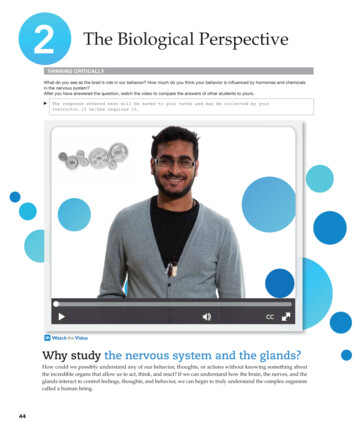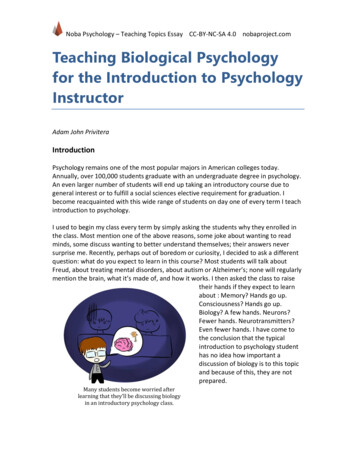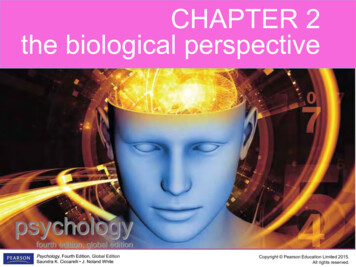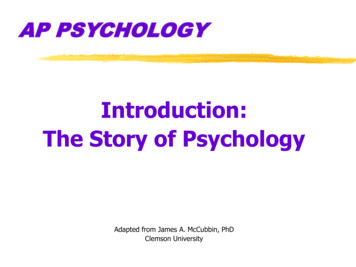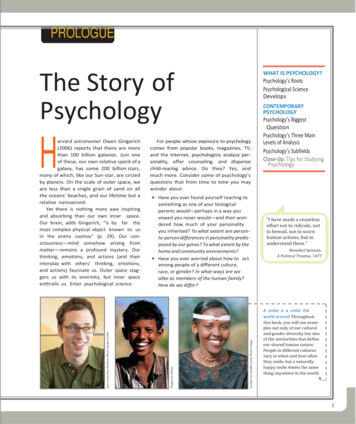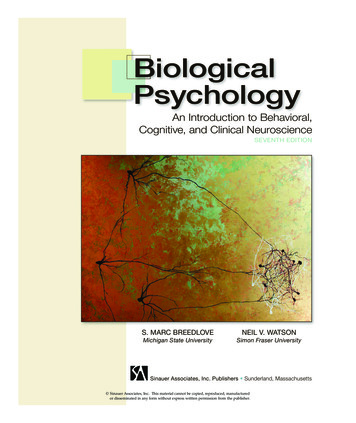
Transcription
BiologicalPsychologyAn Introduction to Behavioral,Cognitive, and Clinical NeuroscienceSEVENTH EDITIONS. MARC BREEDLOVENEIL V. WATSONMichigan State UniversitySimon Fraser UniversitySinauer Associates, Inc. Publishers Sunderland, Massachusetts Sinauer Associates, Inc. This material cannot be copied, reproduced, manufacturedor disseminated in any form without express written permission from the publisher.00 FM Breedlove.indd III3/1/13 1:51 PM
Brief ContentsChapter 1PART IChapter 2Chapter 3Chapter 4Chapter 5Biological Psychology: Scope and Outlook1Biological Foundations of Behavior 21Functional Neuroanatomy: The Nervous System and Behavior 23Neurophysiology: The Generation, Transmission, and Integrationof Neural Signals 59The Chemistry of Behavior: Neurotransmitters andNeuropharmacology 91Hormones and the Brain 125PART IIChapter 6Chapter 7Evolution and Development of the Nervous System 155Evolution of the Brain and Behavior 157Life-Span Development of the Brain and Behavior 185PART IIIChapter 8Chapter 9Chapter 10Chapter 11Biological Foundations of Behavior 221General Principles of Sensory Processing, Touch, and PainHearing, Vestibular Perception, Taste, and Smell 255Vision: From Eye to Brain 291Motor Control and Plasticity 327PART IVChapter 12Chapter 13Chapter 14Regulation and Behavior 359Sex: Evolutionary, Hormonal, and Neural Bases 361Homeostasis: Active Regulation of the Internal EnvironmentBiological Rhythms, Sleep, and Dreaming 423PART VChapter 15Chapter 16Emotions and Mental Disorders 455Emotions, Aggression, and Stress 457Psychopathology: Biological Basis of Behavioral DisordersPART VIChapter 17Chapter 18Chapter 19Cognitive Neuroscience 523Learning and Memory 525Attention and Higher Cognition 561Language and Hemispheric Asymmetry223393491597 Sinauer Associates, Inc. This material cannot be copied, reproduced, manufacturedor disseminated in any form without express written permission from the publisher.00 FM Breedlove.indd VI3/4/13 3:52 PM
Contents1Biological Psychology:Scope and Outlook 1Human or Machine?1The Brain Is Full of Surprises2What Is Biological Psychology?2Five Viewpoints Explore the Biology of BehaviorBOX 1.13We Are All Alike, and We Are All DifferentThree Approaches Relate Brain and Behavior56Neuroplasticity: Behavior Can Change the Brain7Biological Psychologists Use Several Levels of Analysis10A Preview of the Book: Relations between Brain and Behavior11Neuroscience Contributes to Our Understanding of HumanDisorders 12Animal Research Makes Vital Contributions13The History of Research on the Brain and Behavior Beginsin Antiquity 14BOX 1.2Bigger Better? The Case of the Brain and Intelligence17The Cutting Edge Neuroscience Is Advancing at aTremendous Rate 19Visual Summary20PARTI2Biological Foundations of Behavior 21Functional Neuroanatomy:The Nervous System and BehaviorA Stimulating Experience2323The Nervous System Is Composed of Cells24 Sinauer Associates, Inc. This material cannot be copied, reproduced, manufacturedor disseminated in any form without express written permission from the publisher.00 FM Breedlove.indd VII3/1/13 1:51 PM
VIIICONTENTSBOX 2.1 Neuroanatomical Methods Provide Waysto Make Sense of the Brain 26The Nervous System Consists of Central andPeripheral Divisions 344The Chemistry of Behavior:Neurotransmitters andNeuropharmacology 91BOX 2.2 Three Customary Orientations for Viewingthe Brain and Body 40The Birth of a Pharmaceutical ProblemChild 91The Brain Is Described by Both Structure andFunction 43Many Chemical Neurotransmitters Have BeenIdentified 92Specialized Support Systems Protect and Nourishthe Brain 47Neurotransmitter Systems Form a Complex Array inthe Brain 94Brain Imaging Techniques Reveal the Structure andFunction of the Living Human Brain 49The Effects of a Drug Depend on Its Site of Actionand Dose 98BOX 2.3Drugs Affect Each Stage of Neural Conduction andSynaptic Transmission 104Isolating Specific Brain ActivityThe Cutting EdgeThan One 54Visual Summary51Two Heads Are BetterDrugs That Affect the Brain Can Be Divided intoFunctional Classes 10756Drug Abuse Is Pervasive3Neurophysiology: TheGeneration, Transmission,and Integration of NeuralSignals 59The Laughing BrainElectrical Signals Are the Vocabulary of the NervousSystem 60BOX 3.1Changing the Channel67BOX 3.2 Electrical Synapses Work with NoTime Delay 71Synaptic Transmission Requires a Sequence ofEvents 76Neurons and Synapses Combine to MakeCircuits 82Gross Electrical Activity of the Human BrainThe Cutting Edge Optogenetics:Using Light to Probe Brain–BehaviorRelationships 8788The Cutting Edge The Needle and theDamage Undone 1215123Hormones and theBrain 125Life-Threatening LethargySynapses Cause Graded, Local Changes in thePostsynaptic Membrane Potential 71Visual SummaryBOX 4.1 The Terminology of Substance-RelatedDisorders 117Visual Summary5911684125Hormones Have Many Actions in the Body125Hormones Have a Variety of CellularActions 131BOX 5.1 Techniques of Modern BehavioralEndocrinology 134Each Endocrine Gland Secretes SpecificHormones 137BOX 5.2 Stress and Growth: PsychosocialDwarfism 143Hormones Affect Behavior in Many DifferentWays 149Hormonal and Neural Systems Interact to ProduceIntegrated Responses 150The Cutting Edge Hormones Made By theBrain, for the Brain 152Visual Summary154 Sinauer Associates, Inc. This material cannot be copied, reproduced, manufacturedor disseminated in any form without express written permission from the publisher.00 FM Breedlove.indd VIII3/1/13 1:51 PM
IXCONTENTSPARTII6Evolution and Development of the Nervous SystemEvolution of the Brainand Behavior 157We Are Not So Different, Are We?157How Did the Enormous Variety of Species Ariseon Earth? 158Why Should We Study Other Species?162To Each Its Own Sensory World165All Vertebrate Brains Share the Same BasicStructures 167The Evolution of Vertebrate Brains ReflectsChanges in Behavior 169Many Factors Led to the Rapid Evolution of aLarge Cortex in Primates 174BOX 6.3Evolutionary PsychologyEvolution Continues TodayLife-Span Developmentof the Brain andBehavior 185Overcoming Blindness185Growth and Development of the Brain Are OrderlyProcesses 185Development of the Nervous System Can BeDivided into Six Distinct Stages 187BOX 6.1 Why Should We Study ParticularSpecies? 163BOX 6.27155177179BOX 7.1 Degeneration and Regeneration ofNervous Tissue 191BOX 7.2 The Frog Retinotectal SystemDemonstrates Intrinsic and Extrinsic Factorsin Neural Development 200Developmental Disorders of the Brain ImpairBehavior 202Genes Interact with Experience to Guide BrainDevelopment 204BOX 7.3Transgenic and Knockout Mice205The Cutting Edge Are HumansStill Evolving? 181Experience Is an Important Influence on BrainDevelopment 209Visual SummaryThe Brain Continues to Change as We GrowOlder 212183Two Timescales Are Needed to Describe BrainDevelopment 216The Cutting Edge Genetically Reversingan Inherited Brain Disorder 217Visual Summary219PARTIII8Biological Foundations of BehaviorGeneral Principles ofSensory Processing,Touch, and Pain 223What’s Hot? What’s Not?Sensory Processing223223Sensory Receptor Organs Detect Energy orSubstances 224221What Type of Stimulus Was That?225Sensory Processing Begins in Receptor Cells226Sensory Information Processing Is Selective andAnalytical 228BOX 8.1Synesthesia235Touch: Many Sensations BlendedTogether 235 Sinauer Associates, Inc. This material cannot be copied, reproduced, manufacturedor disseminated in any form without express written permission from the publisher.00 FM Breedlove.indd IX3/1/13 1:51 PM
XCONTENTSSkin Is a Complex Organ That Contains a Variety ofSensory Receptors 235The Human Tongue Discriminates Five BasicTastes 276The Dorsal Column System Carries SomatosensoryInformation from the Skin to the Brain 238Chemicals in the Air Elicit Odor SensationsPain: An Unpleasant but AdaptiveExperience 241Human Pain Can Be Measured242Pain Can Be Difficult to Control247The Cutting Edge Sticks andStones 251Visual SummaryThe Cutting EdgeTaste 287Visual Summary10More Than a Matter of288Vision: From Eye toBrain 291When Seeing Isn’t Seeing253281291The Visual System Extends from the Eyeto the Brain 2919Hearing, VestibularPerception, Taste, andSmell 255No Ear for MusicHearingBOX 9.1255BOX 10.1The Basics of Light294Neural Signals Travel from the Retina to SeveralBrain Regions 299BOX 10.2 Eyes with Lenses Have Evolved inSeveral Phyla 302255The Basics of Sound256Each Part of the Ear Performs a SpecificFunction in Hearing 257Auditory System Pathways Run from theBrainstem to the Cortex 262Pitch Information Is Encoded in TwoComplementary Ways 264Neurons at Different Levels of the Visual SystemHave Very Different Receptive Fields 303Area V1 Is Organized in Columns312Color Vision Depends on Special Channels from theRetinal Cones through Cortical Area V4 314BOX 10.3 Most Mammalian Species Have SomeColor Vision 316Brainstem Auditory Systems Are Specializedfor Localizing Sounds 266Perception of Visual Motion Is Analyzed by aSpecial System That Includes Cortical AreaV5 319The Auditory Cortex Performs Complex Tasksin the Perception of Sound 268The Many Cortical Visual Areas Are Organized intoTwo Major Streams 320Hearing Loss Is a Major Disorder of the NervousSystem 270Visual Neuroscience Can Be Applied to AlleviateSome Visual Deficiencies 322Vestibular PerceptionThe Cutting Edge273The Receptor Mechanisms for the VestibularSystem Are in the Inner Ear 273Nerve Fibers from the Vestibular Portion of theVestibulocochlear Nerve (VIII) Synapse in theBrainstem 275Some Forms of Vestibular Excitation ProduceMotion Sickness 276The Chemical Senses: Taste andSmell 276Visual Summary11Seeing the Light323325Motor Control andPlasticity 327What You See Is What You GetThe Behavioral View327327The Control Systems View329 Sinauer Associates, Inc. This material cannot be copied, reproduced, manufacturedor disseminated in any form without express written permission from the publisher.00 FM Breedlove.indd X3/1/13 1:51 PM
CONTENTSThe Neuroscience View330Movements Are Controlled at Several NervousSystem Levels 337BOX 11.1 Cortical Neurons Can Guide a RoboticArm 341XIDisorders of Muscle, Spinal Cord, or Brain CanDisrupt Movement 347The Cutting Edge Cerebellar Glia Play aRole in Fine Motor Coordination 354Visual Summary356Extrapyramidal Systems Also Modulate MotorCommands 345PARTIV12Regulation and BehaviorSex: Evolutionary,Hormonal, and NeuralBases 36113Genitals and Gender: What Makes Us Maleand Female? 361Sexual Behavior359361Reproductive Behavior Can Be Divided intoFour Stages 362Homeostasis: ActiveRegulation of the InternalEnvironment 393A Love-Hate Relationship with FoodHomeostasis Maintains a ConsistentInternal Environment: The Example ofThermoregulation 394BOX 13.1 Integrated Physiological and BehavioralThermoregulation Helps Young Animals toSurvive 399The Neural Circuitry of the Brain RegulatesReproductive Behavior 365Water Moves between Two Major BodyCompartments 400Pheromones Guide Reproductive Behavior inMany Species 367Two Internal Cues Trigger Thirst401The Hallmark of Human Sexual Behavior IsDiversity 369Food and Energy RegulationFor Many Vertebrates, Parental Care DeterminesOffspring Survival 372Nutrient Regulation Helps Prepare forFuture Needs 405Sexual DifferentiationInsulin Is Crucial for the Regulation of BodyMetabolism 408373Sex Determination and Sexual Differentiation OccurEarly in Development 373How Should We Define Gender—by Genes,Gonads, Genitals, or the Brain? 378BOX 12.1 The Paradoxical Sexual Differentiation ofthe Spotted Hyena 381Do Fetal Hormones Masculinize Human Behaviorsin Adulthood? 386Visual SummarySex on the Brain405The Hypothalamus Coordinates Multiple SystemsThat Control Hunger 409Obesity Is Difficult to TreatGonadal Hormones Direct Sexual Differentiation ofthe Brain and Behavior 378The Cutting Edge393415BOX 13.2 Body Fat Stores Are Tightly Regulated,Even after Surgical Removal of Fat 416Eating Disorders Are Life-ThreateningThe Cutting EdgeBelly 419Visual Summary418A Rumbling in the421390391 Sinauer Associates, Inc. This material cannot be copied, reproduced, manufacturedor disseminated in any form without express written permission from the publisher.00 FM Breedlove.indd XI3/1/13 1:51 PM
XIICONTENTS14Biological Rhythms, Sleep,and Dreaming 423When Sleep Gets Out of ControlBiological RhythmsOur Sleep Patterns Change across the LifeSpan 435Manipulating Sleep Reveals an UnderlyingStructure 437423423BOX 14.1Sleep Deprivation Can Be Fatal438Many Animals Show Daily Rhythms in Activity423What Are the Biological Functions of Sleep?The Hypothalamus Houses a Circadian Clock425At Least Four Interacting Neural Systems UnderlieSleep 443Some Biological Rhythms Are Longer or Shorterthan a Day 429Sleep and Waking430Human Sleep Exhibits Different Stages439Sleep Disorders Can Be Serious, EvenLife-Threatening 448The Cutting Edge Can Individual NeuronsBe “Sleepy”? 451430Different Species Provide Clues about theEvolution of Sleep 434Visual Summary453PARTV15Emotions and Mental DisordersEmotions, Aggression,and Stress 457Trouble in ParadiseWhat Are Emotions?16457Lie Detector?Psychopathology: BiologicalBasis of BehavioralDisorders 491“My Lobotomy”458Emotions from the Evolutionary Viewpoint462465Do Distinct Brain Circuits Mediate Emotions?Neural Circuitry, Hormones, and SynapticTransmitters Mediate Violence andAggression 476Stress Activates Many Bodily Responses492Schizophrenia Is the Major NeurobiologicalChallenge in Psychiatry 492461How Many Emotions Do We Experience?491The Toll of Psychiatric Disorders Is HugeBroad Theories of Emotion Emphasize BodilyResponses 458BOX 15.1455468BOX 16.1 Long-Term Effects of AntipsychoticDrugs 502Mood Disorders Are a Major PsychiatricCategory 506BOX 16.2The Season to Be Depressed511There Are Several Types of Anxiety Disorders479513BOX 16.3 Tics, Twitches, and Snorts: The UnusualCharacter of Tourette’s Syndrome 516Stress and Emotions Affect the ImmuneSystem 482Neurosurgery Has Been Used to Treat PsychiatricDisorders 517The Cutting Edge Synaptic Changesduring Fear Conditioning 487Abnormal Prion Proteins Destroy the BrainVisual Summary489518The Cutting Edge Are Abnormal EyeMovements an Endophenotype for Peopleat Risk for Schizophrenia? 519Visual Summary521 Sinauer Associates, Inc. This material cannot be copied, reproduced, manufacturedor disseminated in any form without express written permission from the publisher.00 FM Breedlove.indd XII3/1/13 1:51 PM
XIIICONTENTSPARTVI17Cognitive NeuroscienceLearning andMemory 525Trapped in the Eternal Now52318525Attention and HigherCognition 561One Thing at a TimeFunctional Perspectives on Memory525There Are Several Kinds of Memory andLearning 526Attention561561Attention Selects Stimuli for Processing561Attention May Be Endogenous or ExogenousMemory Has Temporal Stages: Short, Intermediate,and Long 530BOX 18.1OutputSuccessive Processes Capture, Store, and RetrieveInformation in the Brain 532Electrophysiological Techniques Trace RapidChanges of Brain Activity 570BOX 17.1Many Brain Regions Are Involved in Processesof Attention 574Emotions and Memory534Different Brain Regions Process Different Aspectsof Memory 536Neural Mechanisms of MemoryStorage 542565Reaction-Time Responses, from Input to566Two Cortical Networks Collaborate to GovernAttention 578Disorders Provide Clues about the Organizationof Attention 581Memory Storage Requires NeuronalRemodeling 542Consciousness583Invertebrate Nervous Systems ShowPlasticity 545Consciousness Is the Most Mysterious Propertyof the Nervous System 583Synaptic Plasticity Can Be Measured in SimpleHippocampal Circuits 547The Frontal Lobes Govern Our Most ComplexBehavior 588Some Simple Learning in Mammals Relies onCircuits in the Cerebellum 551BOX 18.2In the Adult Brain, Newly Born Neurons May AidLearning 554Learning and Memory Change as We AgeThe Cutting EdgeEngram 557Visual Summary555Phineas GageThe Cutting EdgeYouTube 593Visual Summary590Putting the You in595Artificial Activation of an559 Sinauer Associates, Inc. This material cannot be copied, reproduced, manufacturedor disseminated in any form without express written permission from the publisher.00 FM Breedlove.indd XIII3/1/13 1:51 PM
XIVCONTENTS19Language and HemisphericAsymmetry 597Putting a Name to a Face597Language Has Both Learned and Innate Components597Language Disorders Result from Region-Specific Brain DamageBOX 19.1Williams Syndrome Offers Clues about LanguageBOX 19.2The Wada Test605600605Competing Models Describe Left-Hemisphere LanguageSpecializations 608Reading Skills Are Difficult to Acquire and Frequently Impaired611Brain Stimulation Provides Information about the Organization ofLanguage in the Brain 614Functional Neuroimaging Tracks Activity in the Brain’s LanguageZones 616The Left Brain Is Different from the Right Brain618Deficits in Spatial Perception Follow Right-Hemisphere DamageFollowing Some Injuries, the Brain Can Recover FunctionBOX 19.3The Amazing Resilience of a Child’s BrainBOX 19.4Contact Sports Can Be Costly624626627628The Cutting Edge Studying Connectivity in theLiving Brain 630Visual SummaryAppendixGlossary632A–1G–1Illustration CreditsReferencesIC–1R–1Author IndexSubject IndexAI–1SI–1 Sinauer Associates, Inc. This material cannot be copied, reproduced, manufacturedor disseminated in any form without express written permission from the publisher.00 FM Breedlove.indd XIV3/1/13 1:51 PM
Chapter 1 Biological Psychology: Scope and Outlook 1 PART I Biological Foundations of Behavior 21 Chapter 2 Functional Neuroanatomy: The Nervous System and Behavior 23 Chapter 3 Neurophysiology: The Generation, Transmission, and Integration of Neural Signals 59 Chapter 4 The Chemistry of Behavior: Neurotransmitters and Neuropharmacology 91 Chapter File Size: 892KB
